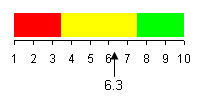
|
Ensuring an Information Highway This initiative focuses on enabling all parts of Minnesota, including rural areas, to participate equally in the modern information age and the opportunities offered by the digital economy. Affordable access to broadband connectivity and associated services fosters economic growth. It requires a robust and efficient communications infrastructure deployed in partnership with private telecommunications and cable companies throughout the state.
The Big Accounting Initiative Score Number of rural communities served by a high-speed community networks (includes DSL). Number of town-to-town segments completed in the Connecting Minnesota Project (or its successor). Number of exchanges in rural Minnesota with at least one competitive local exchange carrier. |
|||||||||||||||||||||||||||

|
|||||||||||||||||||||||||||
|
|
|
||||||||||||||||||||||||||
Note: Steady progress is being made toward ensuring that no community is excluded from the opportunity to participate in the digital economy. A common minimum access standard has been defined at 256 kbps (kilobytes per second) or higher. "Reasonable cost" is a judgment made based on a comparison of options and costs in various parts of the state. |
|||||||||||||||||||||||||||
| top
|
|||||||||||||||||||||||||||
|
|
|
||||||||||||||||||||||||||
Note: The Information Highway plan calls on private sector telecommunications providers to deploy high-speed Internet connectivity and content throughout the state. This indicator measures the actual results of cable companies in providing high-speed access via cable modems. |
|||||||||||||||||||||||||||
| top
|
|||||||||||||||||||||||||||
Number of rural communities served by a high-speed community networks (includes DSL). |
|||||||||||||||||||||||||||
|
|
|
||||||||||||||||||||||||||
Note: Availability of high-speed Internet access is important in both metro and rural areas of the state. However, penetration into the rural communities is an important indicator of success for the Information Highway initiative since these areas have been less likely to be served by a high-speed community network. Factors inhibiting rural access may include sparse customer populations, lack of competition, lagging consumer awareness of opportunities available with the information age, and difficulty in achieving profit margins for private sector companies. High-speed networks can include cable, wireless or DSL (digital subscriber line) technology, a high-speed data service that people subscribe to over and above their regular telephone service. |
|||||||||||||||||||||||||||
| top
|
|||||||||||||||||||||||||||
Number of town-to-town segments completed in the Connecting Minnesota Project (or its successor). |
|||||||||||||||||||||||||||
|
|
|
||||||||||||||||||||||||||
Note: Through the Connecting Minnesota Project, high-speed telecommunication access is provided to Minnesota residents via a two-step process: first fiber-optic cable is installed between communities, and then local access providers take the connection further into homes and businesses. This measurement tracks the first step in this process, where fiber is made available to communities. Construction contracting problems stalled the Connecting Minnesota Project during 2001. Timetables and targets are now being re-assessed, and will be reset and restarted accordingly. |
|||||||||||||||||||||||||||
| top
|
|||||||||||||||||||||||||||
Number of exchanges in rural Minnesota with at least one competitive local exchange carrier. |
|||||||||||||||||||||||||||
|
|
|
||||||||||||||||||||||||||
Note: Competition around the state impacts not only the availability of high-speed digital services but also improves affordability. Through consumer outreach, and legislative and regulatory adjustments, the Ventura administration is working to promote more telephone competition in rural Minnesota. |
|||||||||||||||||||||||||||
| top
|
|||||||||||||||||||||||||||





